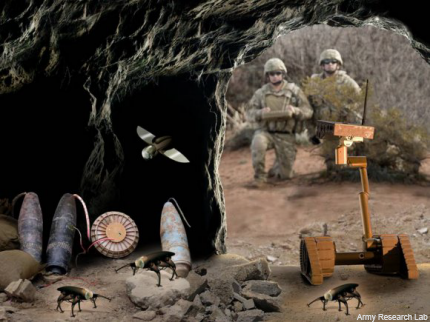Tiny robots could conduct surveillance, search houses for soldiers
ARL partners with academia and industry to develop technologies for autonomous, insect-sized systems.

With the growth of IEDs and other weapons used against unsuspecting soldiers in complex and urban environments, the demand for squad-level reconnaissance capabilities has significantly increased.
One possible solution is the use of small, insect-like robots that could collaborate together to form multifunctional, mobile microsystems to enhance situational awareness.
Researchers of the Micro Autonomous Systems and Technology (MAST) program of the Army Research Lab are collaborating with industry and academia to develop ground, aerial and control systems for robotics. The collaboration includes researchers from ARL and BAE Systems, as well as several universities.
The program focuses on technological and scientific areas of interest that would be ultimately used to develop micro autonomous robotic systems that would have to be able to quietly conduct several operational scenarios such as searching buildings, searching in caves or a demolished building, or conduct perimeter defense.
Current systems are both too large to conduct these types of operations and lacking in important autonomous capabilities. For instance, Qinetiq’s Dragon Runner robot, which weighs 5 pounds, can be thrown into buildings to conduct reconnaissance, but is too large to remain concealed and can’t navigate smaller spaces. In contrast, MAST seeks to develop crawlers that are 4 to 20 grams in weight, according to a 2010 overview of the program.
"At the time, we were one of the few in the U.S. looking at this issue," said Dr. Joseph Mait, the creator of the program, according to the Army. "The vision for MAST came about when we realized we couldn't take solutions that worked on large scales and shrink them down for a large platform. It wasn't going to be just a platforms, sensors or algorithms program; we needed to look at the system as a whole, which is what led to the genesis of MAST."
Several challenges arise in dealing with such small systems, however. For instance, millimeter-sized robotic leg structures will have to be developed for ground robotic vehicles, and aerial vehicles will have to be able to resist gusts of wind, according to ARL. And because current sensor systems such as laser range finders are too heavy and expensive for tiny robots, the program is looking at ways to adapt the visual systems of insects.
Researchers are also looking at how to increase communication, networking and collaboration capabilities between different autonomous platforms, since the platforms will have to be able to navigate through structures and debris and conduct surveillance with minimum direct human control.
"The end result is to create a system that would be a true teammate for soldiers, one that could keep up with their speed," said Dr. Brett Piekarski, chief of ARL’s Micro and Nano Materials and Devices Branch of the Sensors and Electron Devices Directorate of MAST. "We want these systems to be small, fast, lightweight, cost-effective, and have the ability to go wherever the solider needs to go."




